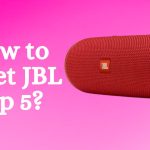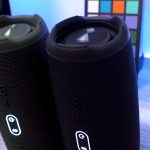If you have a JBl speaker and want to connect it to your TV, you can do it easily through simple steps. Here’s a complete guide about connecting JBL speakers to your TV.
Quick Answer: Most of the speakers from JBL can connect to the TV via Bluetooth connection. All you need to do is turn on the speaker, putting the speaker in the pairing mode. Go to the TV settings, turn on the TV’s Bluetooth, and find and tap on the name of the speaker in the list to form the connection.
Steps to connect JBL Speaker to TV
Check TV’s Connectivity Options
The first step to connecting JBL Speakers with your TV is to check the type of connection your TV supports. The JBL speakers could be connected to the TV Via Bluetooth or AUX input, as they do not support HDMI Input.
So, if your TV has a Bluetooth Connectivity option, you can connect the speakers to the TV; otherwise, you’ll have to opt for the AUX input.
Connecting JBL Speakers Via Bluetooth
If your TV supports Bluetooth connectivity, you can connect most of the JBL speakers to your TV wirelessly via Bluetooth.
Here’s a list of JBL Speakers you can connect to your TV Via Bluetooth and the steps to set up the connection.
Connecting JBL Flip, Clip, Charge, Link, Xtreme Series
These portable speaker series of JBL are easier to carry and can connect to the source Via Bluetooth. Here are the steps to connect them to your TV.
- Turn on the JBL speaker and put it in the pairing mode.
- The speaker will turn into pairing mode automatically, or you can press the button once and wait until the light flashes blue or white.
- Turn on your TV and Go to the TV’s settings.
- In the Settings, search for Bluetooth or Connections Option.
- Click on Bluetooth and Turn it on.
- Wait for the Bluetooth to detect your JBL speaker.
- Next, tap on the speaker’s name and wait until it’s connected to the TV.
- Play some music on your TV to test the connection.
Connecting JBL Speakers to TV Via AUX
If your TV doesn’t support Bluetooth connectivity but has an AUX input mode, you can connect the TV to the JBL speaker through a wired connection. There are several JBL speakers which support an AUX connection. Here’s how you can connect these speakers to the TV.
Connecting JBL Flip 4, Charge 4, Xtreme 2, Boombox, PartyBox 100, Go 2, Clip 2:
- Locate the AUX port located in your TV and JBL Speaker.
- Take the AUX cable of the required length and plug one end into the speaker and the other into the TV’s AUX port.
- Turn on the JBL speaker.
- Turn on your TV and go to TV Settings.
- In the Settings Search for Audio Output Settings.
- Set the Audio Output to AUX.
- Play some music on your TV to test the connection.
Connecting JBL Speakers Via Bluetooth Transmitter
If you have a JBL speaker that does not support AUX input, while your TV doesn’t have a Bluetooth connectivity option and you need to connect the speaker to the TV, you’ll have to do it with the help of a Bluetooth transmitter. Here’s a list of JBL speakers that do not support AUX input, and you may need a Bluetooth transmitter if your TV doesn’t have Bluetooth.
Connecting JBL Flip 5, Charge 5, Clip 4, Go 3, Link 10/20/300, Pulse 4
These are JBL portable Speakers with no AUX input port to connect to your TV via a wired connection. Here’s how you can connect them to the TV via Bluetooth Transmitter.
- Connect a Bluetooth Transmitter to the TV via the AUX port or the available connection. Bluetooth transmitters support audio inputs like AUX, Optical, and RCA connectors.
- Put one cable end (AUX/Optical/RCA) into the TV port and the second into the Bluetooth Transmitter.
- Next, turn on the JBL speaker and put it in pairing mode.
- Turn on the Bluetooth adapter and go to your TV settings to connect the Bluetooth transmitter to the speaker.
- Wait until the two devices are connected.
- Test the connection by playing music on your TV.
- You might have to set up the Audio Output settings to AUX output or Bluetooth if you can’t hear the audio.
Final Words
JBL speakers are a great addition to your home theater. However, the steps to connecting these speakers may vary depending on the type of connection your TV supports and the model of JBL speaker that you have. Some JBL speakers support Bluetooth and AUX input, allowing you to connect the speakers via wired or wireless.
If your TV supports Bluetooth, you can connect most JBL speakers to it without hassle. However, if the TV doesn’t support Bluetooth connection but has an AUX input, and you have a JBL speaker with an AUX input option, you can go for wired connectivity.
Finally, if your TV supports AUX input, but your speaker doesn’t have any AUX input, you can use a Bluetooth transmitter to connect the two.
Just ensure to follow the correct connectivity steps to get the connection started.
Frequently Asked Questions
Yes, you can do it if your speakers have Partyboost of Connect + feature. Connect the speakers using one of these features, and connect the first to the TV.
If your speaker doesn’t appear in the list of available Bluetooth devices on your TV, you need to ensure that your speaker is in pairing mode.
Press the Bluetooth button once to put it in pairing mode manually. Put the speaker closer to the TV or in the connectivity range. Finally, turn off other Bluetooth devices in the room to avoid signal interference.
Ensure that the two devices are in connectivity range and the line of sight. Set the audio settings from the TV settings, and enable Bluetooth Audio synchronization or latency reduction feature if available.
You can easily control the speaker’s volume by the TV’s remote, the JBL speaker’s control, or both.

I’m Shaun Conroy, an audiophile & founder of HiFi Audios. Holding a Bachelor’s in Sound Engineering, I bring deep expertise in audio devices and offer insights & recommendations to fellow enthusiasts.





